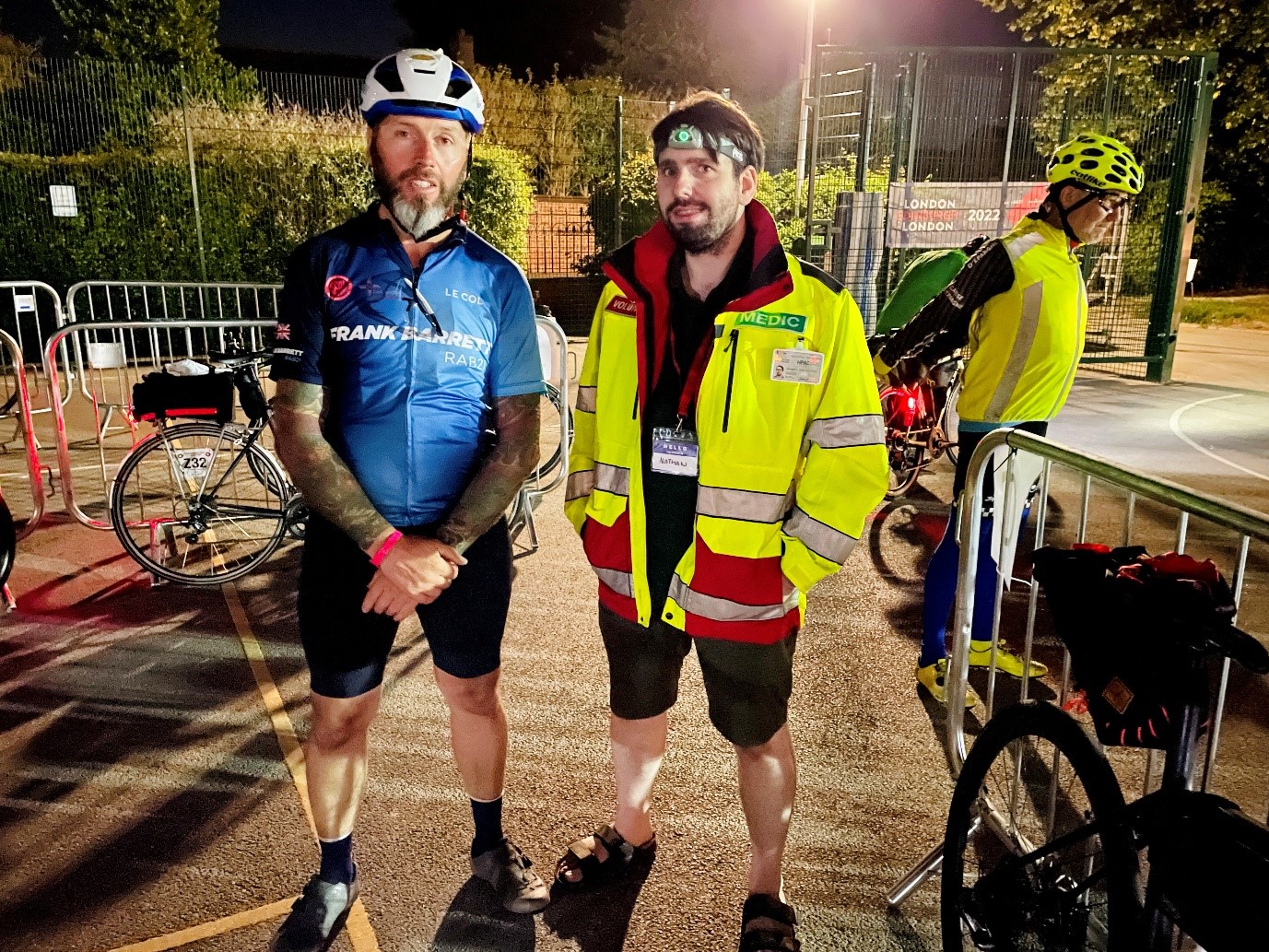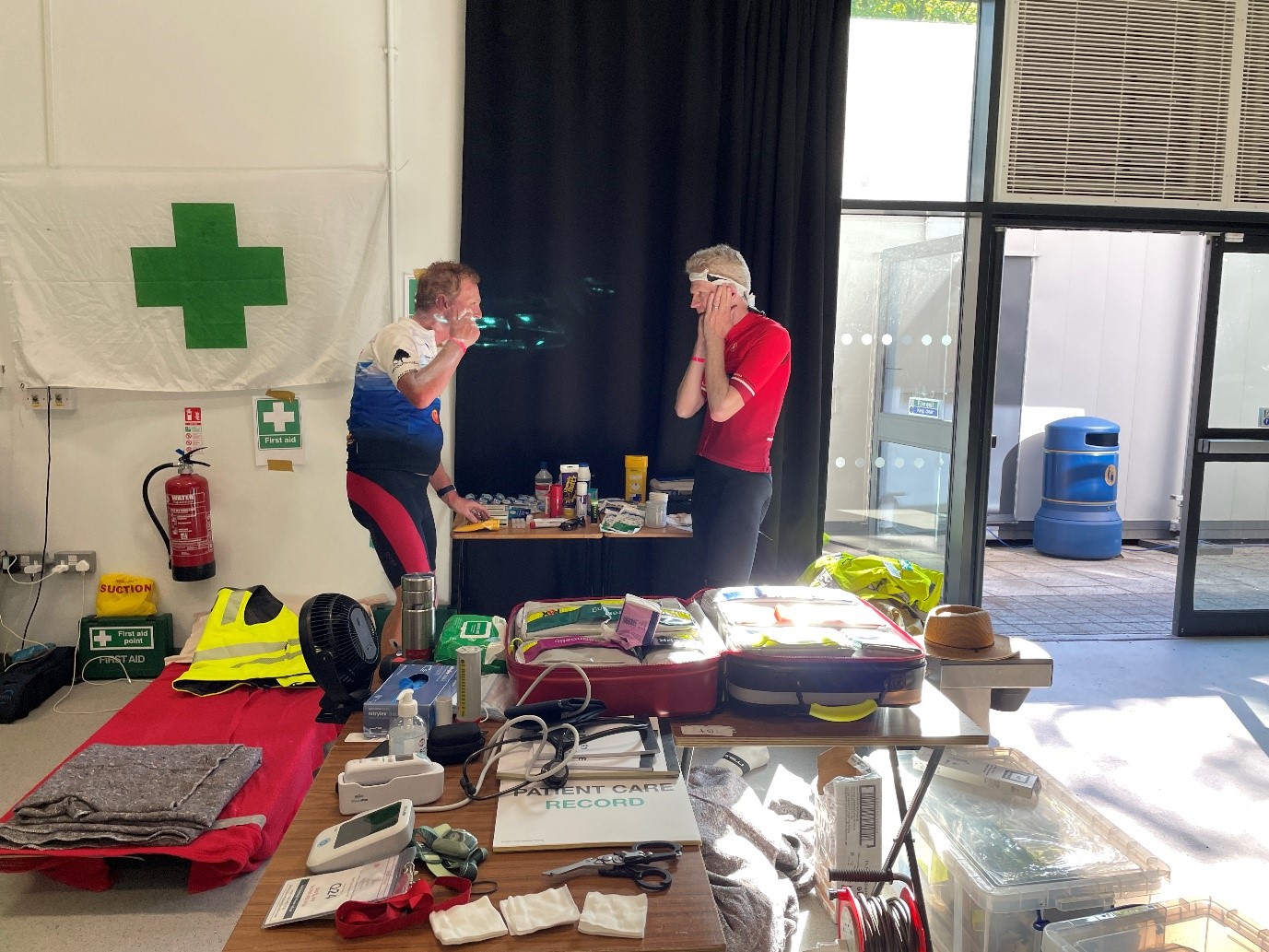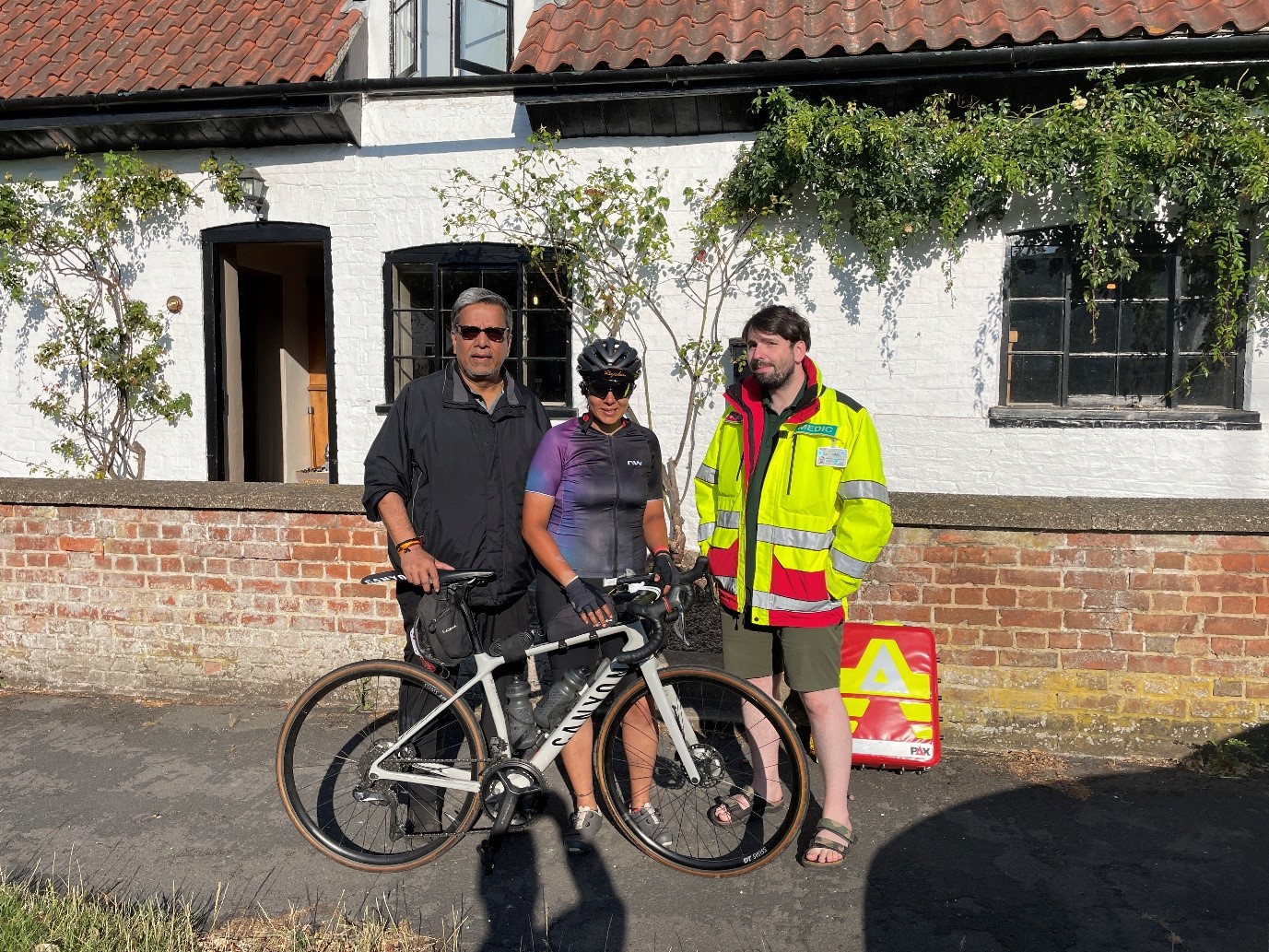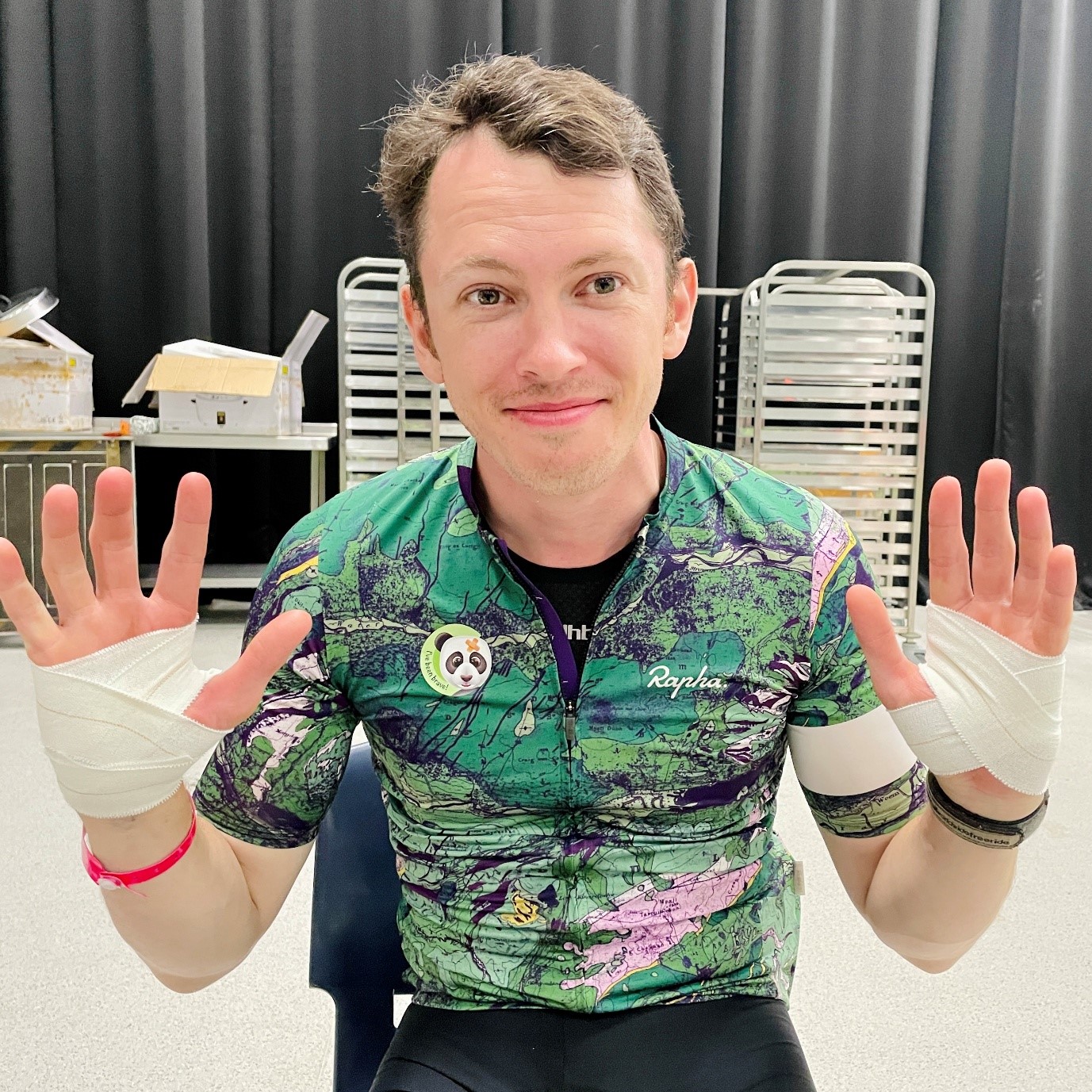Keep calm and chamois on: Our practical guide to avoiding saddle sores
Written by: Nathan Clough, LEL 2025 Medical Director (pictured with LEL rider Frank Barrett) at the Louth control

Let us introduce you to an ailment that affected at least a couple of hundred riders during our 2022 edition of London Edinburgh London - saddle sores, brought on by some of the hottest, most prolonged weather our volunteer team have ever experienced during this decades-old event.
A saddle sore is basically your backside’s way of protesting after too many hours in the saddle. Think of it as a painful mix of chafing, pressure, and irritation that shows up as raw spots, bumps, or even infections where your skin meets the bike seat. Let’s be honest, there’s nothing that kills the romance of a long ride faster than the creeping sting of a saddle sore. One day you’re crushing miles like a Tour de France hopeful, and the next, you’re walking like you just lost a fight with a cheese grater. This is your no-nonsense, saddle-savvy guide to keeping your rear in the clear, because the only thing that should be burning after five days in the saddle is your quads.
The pragmatic approach

Vibhav Shinde (one of our large contingent of riders from India) who very nearly needed to end his ride at the Hessle control, but we kept him in the game after a few hours of TLC in the medical bay.
Before you reach for the antiseptic cream, let’s talk prevention. Most saddle sores can be dodged entirely with a little planning, the right gear, and some basic hygiene. This section covers the practical stuff - bike fit, clothing, chamois cream, and smart riding habits - because the best way to treat a saddle sore is not getting one in the first place. Here’s my personal take on what you should do as a bare minimum:
- Get your skin very used to withstanding a long ride in changing conditions. So lots of training! Very similar to how a rower develops thicker skin on pressure points on certain parts of the hand to avoid blistering.
- Unless you're very confident your underwear is working for you, I'd absolutely lose them and go nude under. Female riders with normal bodily functions that occur during a ride may prefer to have a very low profile (that no VPL stuff) and breathable undergarment, but the pragmatist in me would suggest regular showers at controls would be the better option than the additional layer that adds a chafing risk. Each to their own, and it’s important to go with a layering system that suits you and your body best. That said, you can get away with a lot more on a mega audax like LEL than you can on a club ride, so I'd personally opt for long-distance and sustainable comfort over modesty.
- Chamois cream, and plenty of it! Yes, it may froth up a bit when it rains, but decant enough to get you between bag drops into a reusable container and apply throughout the day, after its rained (as it takes the cream with it), when you feel it's getting a bit dry under there. Then pack big tubs/tubes at your bag drops for re-stock north and southbound. I'm an absolute fanboy of Chamois Butt'r, but do be sure whatever you choose is thick and of high quality - you'll thank yourself for it later!
- Invest in a saddle that reduces pressure where you typically get sores - On my LEL ride in 2017 I rode on an Infinity seat that suspends you in the saddle like a hammock. Quite pricey, especially if importing to the UK like I did, but that made the world of difference to comfort levels, and that's before any physical sores (which never actually presented). Just be sure to get one that fits you, and not one that literally worth its weight in gold or that your mate at the local club recommended because ‘it’s a great fit’ for them.
- Keep very well hydrated throughout the ride - no amount of fancy drinks and gels will substitute for good ol' water that can be easily filtered and put to use by your body to keep muscles supple. Your skin is the first thing your body will neglect under stress, which is what LEL puts you through even if you're happy as larry, so you must work hard to keep your skin on side! Be sure to change your water at each control, and do treat yourself to a full fat Coke from a corner shop every once in a while, because you'll be sick of water mid-ride - that was my carrot on a stick in previous audaxes, and encouraged me to keep up with the water.
- In the same vein as hydration - if it's sunny, get the suncream on! Whilst every control will have this, it's a fair distance between controls where you can burn, especially on long, open and flat straights like the Fens north of Cambridge. You know how and where to apply it, but the science behind this is when your skin burns you lose a heck of a lot of moisture in your body.
The ‘belt and braces’ approach

Sometimes, even the best-laid plans (and perfectly padded bib shorts) can’t save you. When prevention fails and you find yourself squirming instead of spinning, it’s time for damage control. This part dives into recognising saddle sores, knowing when to rest, what to apply, and when to actually talk to a volunteer medic - yes, even about your bum! There are over 80 volunteers medics across the entire route this year, some based at controls, others out on the road, and a select few advising from afar, so you’re very well supported.
Here are my recommendations that if applied in full should almost guarantee you a pain-free LEL:
- Take regular showers throughout the ride coupled with bib short changes at each bag drop. Big caveat on this - showers take time and are faffy, and bib shorts are expensive. When riding in 2017 I was able to do the entire northbound route with only one shower halfway up and elected not to change my bib shorts as I preferred my broken in ones, so use your own judgement as to how much you clean and change, but the science is that bacteria and humidity down there is a breeding ground for everything that will cause you trouble, especially after you get sores.
- When chamois cream isn't enough, please, please, please drop into our First Aid Point which you'll find at each control this year and ask for Sudocrem (an antiseptic healing cream) - we're making a point of not rationing anything out, so if you need it, ask for it! We want you to complete LEL and will do everything to keep you on the road rather than taking a train back to Writtle (well, Chelmsford actually)! The process is super quick - one of the medics will scoop some cream into a biodegradable tub for you to apply elsewhere in private (after a shower when fully dry is our gold standard, so be sure to pick up beforehand), then you can either scoop some into strategic places, or open up the tub for a full smear on the general sore areas. This is what most of our riders had with saddle sores at the Hessle control (and others, so I've heard) in 2022, and they all went on to manage it well. We had a heatwave in 2022 that lasted most of the route, so you'll have been managing well not to have had some form of sores. When you need Sudocrem we call that a 'stage 1’ saddle sore.
- When Sudocrem isn't quite hitting the mark, you may elect to make use of some of our gels with an anti-inflammatory, including use of some of the oral drugs we'll have on offer that provide the same benefits. A large proportion of our volunteers aren't able to 'prescribe' you these, so they may suggest you help yourself, but they will have been provided with some advice to pass onto you. If receiving this treatment path we'd suggest you check into each First Aid Point thereafter for a check up and likely a re-application with the hope of dropping down to just needing Sudocrem. This does not replace chamois cream, which would be my number one preventative measure for saddle sores as it creates a slippery barrier between your bum and the friction that exacerbates such sores. When you need gels we call that a 'Stage 2’ saddle sore'.
- When Stage 1 and Stage 2 saddle sore treatments don't work, and you end up with open wounds or cracked skin, you're essentially one one stage from us needing to suggest you call it a day. 'Stage 3’ saddle sores', as we call them, are not something you want to have as the treatment path isn't the nicest on a long ride like LEL. At this stage you're getting Savlon (an antibacterial antiseptic cream) and a waterproof, see-through dressing. You'll 100% need to check in at each control's First Aid Point for an assessment which is almost certainly going to require a re-application of antiseptic cream and a re-dress after a thorough shower. As you're unlikely to heal from this during the period of LEL, it's highly unlikely we'll be dropping you back to Stage 1 or Stage 2 Saddle Sore treatment paths, and having a dressing adds a dynamic you'd rather not have on an audax, so I ask all riders to do their best to avoid getting to this stage, as will our medic volunteers.

Team India rider running behind the clock southbound through Lincolnshire after receiving Stage 2 saddle sore treatment at the Medical Director’s cottage in the Wolds
And our closing advice - us audaxers are brilliant at pushing on and blocking out the pain. It's absolutely critical to listen to our bodies, and having consistent and dependable medical support at each control that provides fast and targeted treatment is what we hope will mean you'll pop in and ask for some preventative treatment or advice on anything causing a niggle. The instruction to our medical volunteers and controllers will be one of keeping you in the game and not looking for reasons to pull you out of it. We always give our riders two options - what we would do in your (cycling) shoes, and our professional advice - so whilst our professional advice may be to call it a day, we will (and hopefully our wider volunteers) do all we can to not let it come to that. And saying all of that, YOU will be the biggest preventative measure - that's the training you do beforehand, the equipment you choose, the bag drop strategy and ensuring you're taking on and applying as much as is required to keep your body under equilibrium under the stress every audaxers' body goes through regardless of ability. If you manage that, then your only barrier to finishing will be mental (which is what got me in 2017!)

‘I’ve been brave’ panda stickers for all at the Hessle and Louth First Aid Points. 2025 will be the year of the unicorn!
We look forward to exclaiming 'chapeau! as you cross the finish line in Writtle in August 2025!
